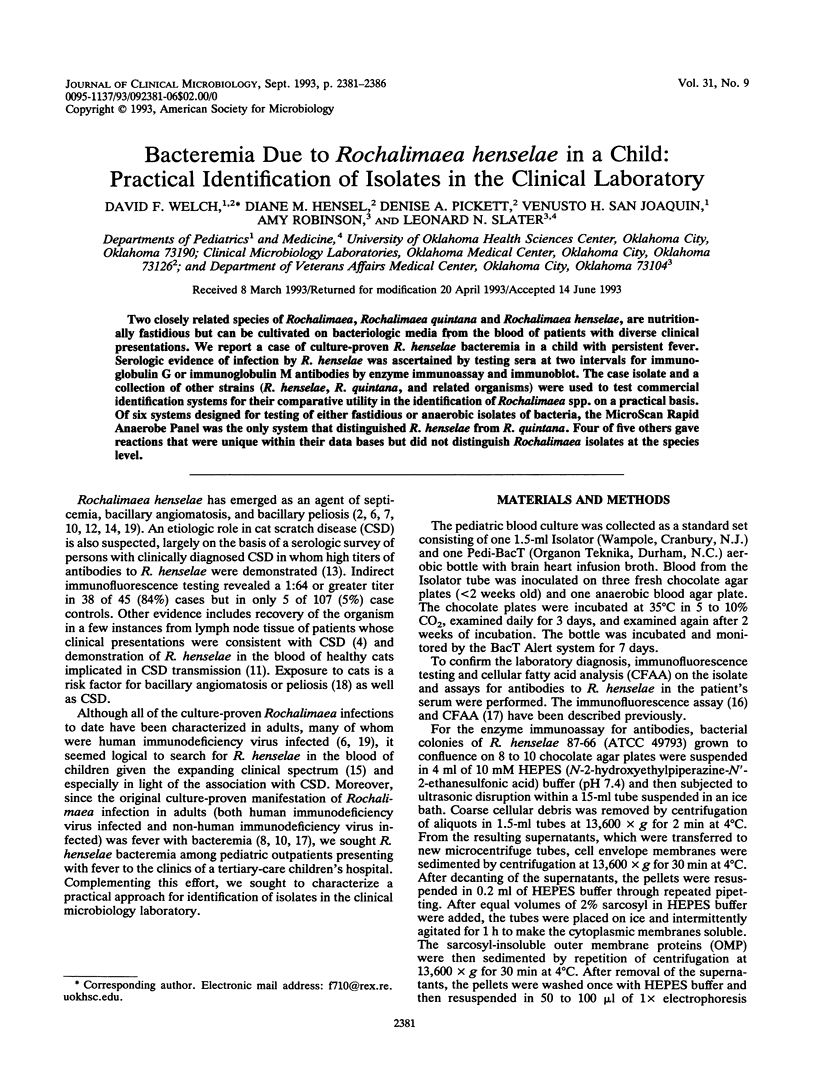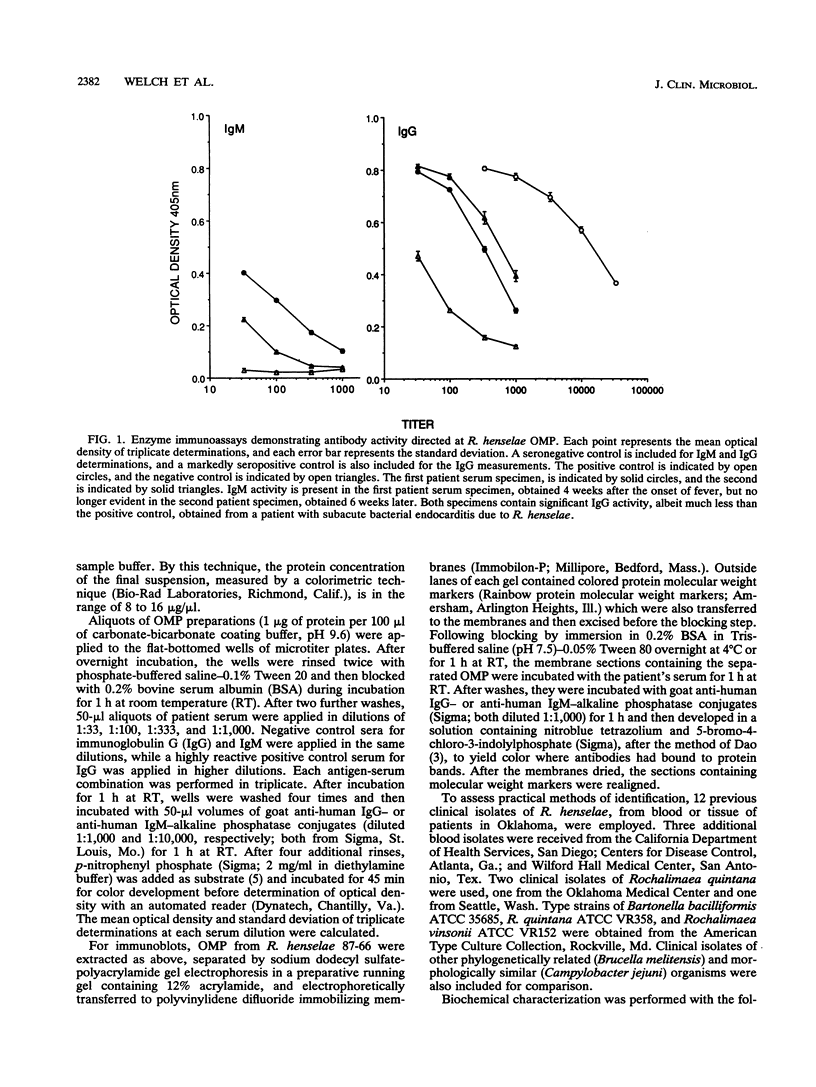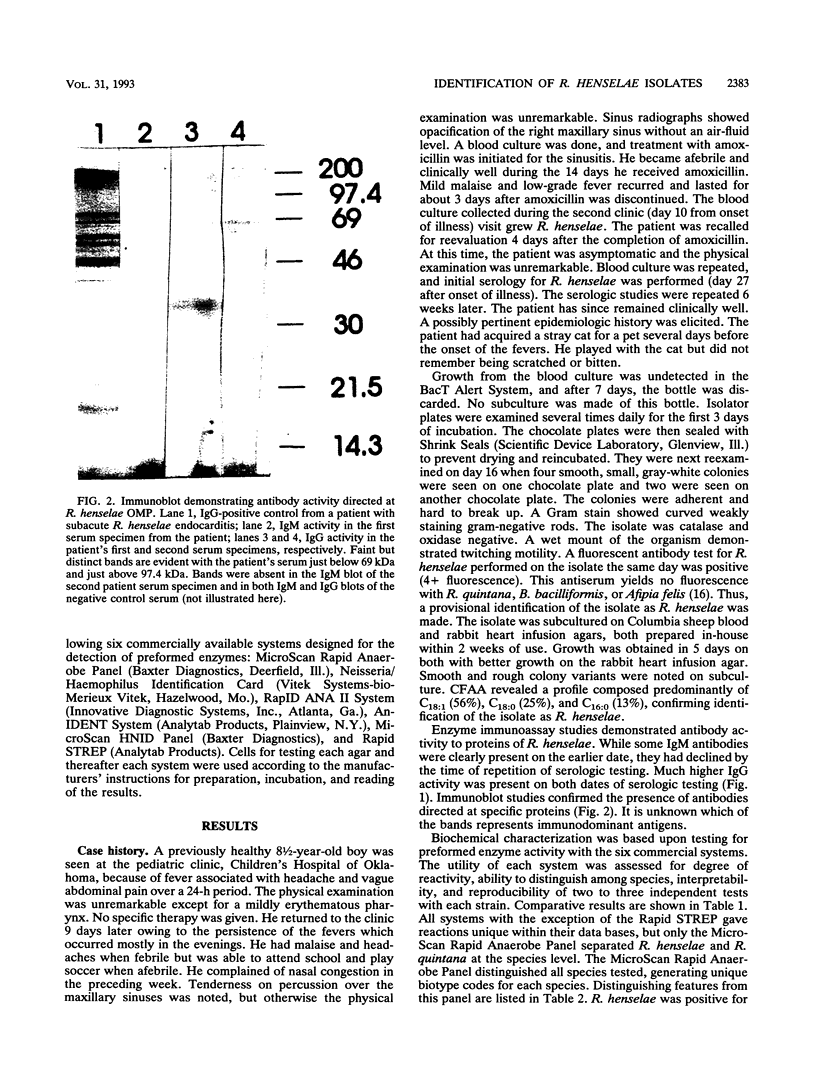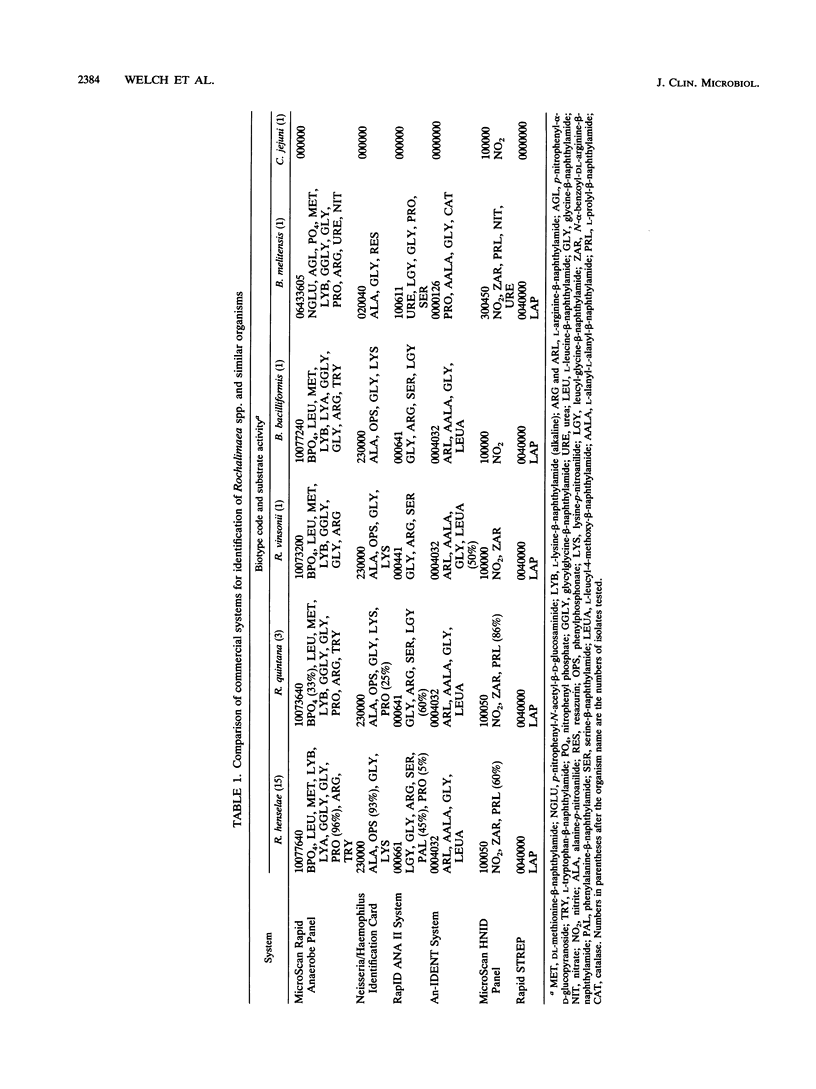Abstract
Two closely related species of Rochalimaea, Rochalimaea quintana and Rochalimaea henselae, are nutritionally fastidious but can be cultivated on bacteriologic media from the blood of patients with diverse clinical presentations. We report a case of culture-proven R. henselae bacteremia in a child with persistent fever. Serologic evidence of infection by R. henselae was ascertained by testing sera at two intervals for immunoglobulin G or immunoglobulin M antibodies by enzyme immunoassay and immunoblot. The case isolate and a collection of other strains (R. henselae, R. quintana, and related organisms) were used to test commercial identification systems for their comparative utility in the identification of Rochalimaea spp. on a practical basis. Of six systems designed for testing of either fastidious or anaerobic isolates of bacteria, the MicroScan Rapid Anaerobe Panel was the only system that distinguished R. henselae from R. quintana. Four of five others gave reactions that were unique within their data bases but did not distinguish Rochalimaea isolates at the species level.
Full text
PDF





Images in this article
Selected References
These references are in PubMed. This may not be the complete list of references from this article.
- Brenner D. J., Hollis D. G., Moss C. W., English C. K., Hall G. S., Vincent J., Radosevic J., Birkness K. A., Bibb W. F., Quinn F. D. Proposal of Afipia gen. nov., with Afipia felis sp. nov. (formerly the cat scratch disease bacillus), Afipia clevelandensis sp. nov. (formerly the Cleveland Clinic Foundation strain), Afipia broomeae sp. nov., and three unnamed genospecies. J Clin Microbiol. 1991 Nov;29(11):2450–2460. doi: 10.1128/jcm.29.11.2450-2460.1991. [DOI] [PMC free article] [PubMed] [Google Scholar]
- Cockerell C. J., Friedman-Kien A. E. Epithelioid angiomatosis and cat scratch disease bacillus. Lancet. 1988 Jun 11;1(8598):1334–1335. doi: 10.1016/s0140-6736(88)92146-0. [DOI] [PubMed] [Google Scholar]
- Dao M. L. An improved method of antigen detection on nitrocellulose: in situ staining of alkaline phosphatase conjugated antibody. J Immunol Methods. 1985 Oct 10;82(2):225–231. doi: 10.1016/0022-1759(85)90354-0. [DOI] [PubMed] [Google Scholar]
- Dolan M. J., Wong M. T., Regnery R. L., Jorgensen J. H., Garcia M., Peters J., Drehner D. Syndrome of Rochalimaea henselae adenitis suggesting cat scratch disease. Ann Intern Med. 1993 Mar 1;118(5):331–336. doi: 10.7326/0003-4819-118-5-199303010-00002. [DOI] [PubMed] [Google Scholar]
- Hirano K., Iiizumi Y., Hayashi Y., Tanaka T., Sugiura M., Hayashi K., Lu Z. D., Iino S. A highly sensitive assay method for human placental alkaline phosphatase involving a monoclonal antibody bound to a paper disk. Anal Biochem. 1986 May 1;154(2):624–631. doi: 10.1016/0003-2697(86)90038-2. [DOI] [PubMed] [Google Scholar]
- Koehler J. E., Quinn F. D., Berger T. G., LeBoit P. E., Tappero J. W. Isolation of Rochalimaea species from cutaneous and osseous lesions of bacillary angiomatosis. N Engl J Med. 1992 Dec 3;327(23):1625–1631. doi: 10.1056/NEJM199212033272303. [DOI] [PubMed] [Google Scholar]
- LeBoit P. E., Berger T. G., Egbert B. M., Yen T. S., Stoler M. H., Bonfiglio T. A., Strauchen J. A., English C. K., Wear D. J. Epithelioid haemangioma-like vascular proliferation in AIDS: manifestation of cat scratch disease bacillus infection? Lancet. 1988 Apr 30;1(8592):960–963. doi: 10.1016/s0140-6736(88)91779-5. [DOI] [PubMed] [Google Scholar]
- Lucey D., Dolan M. J., Moss C. W., Garcia M., Hollis D. G., Wegner S., Morgan G., Almeida R., Leong D., Greisen K. S. Relapsing illness due to Rochalimaea henselae in immunocompetent hosts: implication for therapy and new epidemiological associations. Clin Infect Dis. 1992 Mar;14(3):683–688. doi: 10.1093/clinids/14.3.683. [DOI] [PubMed] [Google Scholar]
- Patnaik M., Schwartzman W. A., Barka N. E., Peter J. B. Possible role of Rochalimaea henselae in pathogenesis of AIDS encephalopathy. Lancet. 1992 Oct 17;340(8825):971–971. doi: 10.1016/0140-6736(92)92855-a. [DOI] [PubMed] [Google Scholar]
- Reed J. A., Brigati D. J., Flynn S. D., McNutt N. S., Min K. W., Welch D. F., Slater L. N. Immunocytochemical identification of Rochalimaea henselae in bacillary (epithelioid) angiomatosis, parenchymal bacillary peliosis, and persistent fever with bacteremia. Am J Surg Pathol. 1992 Jul;16(7):650–657. doi: 10.1097/00000478-199207000-00003. [DOI] [PubMed] [Google Scholar]
- Regnery R. L., Anderson B. E., Clarridge J. E., 3rd, Rodriguez-Barradas M. C., Jones D. C., Carr J. H. Characterization of a novel Rochalimaea species, R. henselae sp. nov., isolated from blood of a febrile, human immunodeficiency virus-positive patient. J Clin Microbiol. 1992 Feb;30(2):265–274. doi: 10.1128/jcm.30.2.265-274.1992. [DOI] [PMC free article] [PubMed] [Google Scholar]
- Regnery R. L., Olson J. G., Perkins B. A., Bibb W. Serological response to "Rochalimaea henselae" antigen in suspected cat-scratch disease. Lancet. 1992 Jun 13;339(8807):1443–1445. doi: 10.1016/0140-6736(92)92032-b. [DOI] [PubMed] [Google Scholar]
- Regnery R., Martin M., Olson J. Naturally occurring "Rochalimaea henselae" infection in domestic cat. Lancet. 1992 Aug 29;340(8818):557–558. doi: 10.1016/0140-6736(92)91760-6. [DOI] [PubMed] [Google Scholar]
- Relman D. A., Falkow S., LeBoit P. E., Perkocha L. A., Min K. W., Welch D. F., Slater L. N. The organism causing bacillary angiomatosis, peliosis hepatis, and fever and bacteremia in immunocompromised patients. N Engl J Med. 1991 May 23;324(21):1514–1514. doi: 10.1056/NEJM199105233242117. [DOI] [PubMed] [Google Scholar]
- Schwartzman W. A. Infections due to Rochalimaea: the expanding clinical spectrum. Clin Infect Dis. 1992 Dec;15(6):893–900. doi: 10.1093/clind/15.6.893. [DOI] [PubMed] [Google Scholar]
- Slater L. N., Coody D. W., Woolridge L. K., Welch D. F. Murine antibody responses distinguish Rochalimaea henselae from Rochalimaea quintana. J Clin Microbiol. 1992 Jul;30(7):1722–1727. doi: 10.1128/jcm.30.7.1722-1727.1992. [DOI] [PMC free article] [PubMed] [Google Scholar]
- Slater L. N., Welch D. F., Hensel D., Coody D. W. A newly recognized fastidious gram-negative pathogen as a cause of fever and bacteremia. N Engl J Med. 1990 Dec 6;323(23):1587–1593. doi: 10.1056/NEJM199012063232303. [DOI] [PubMed] [Google Scholar]
- Tappero J. W., Mohle-Boetani J., Koehler J. E., Swaminathan B., Berger T. G., LeBoit P. E., Smith L. L., Wenger J. D., Pinner R. W., Kemper C. A. The epidemiology of bacillary angiomatosis and bacillary peliosis. JAMA. 1993 Feb 10;269(6):770–775. [PubMed] [Google Scholar]
- Welch D. F., Pickett D. A., Slater L. N., Steigerwalt A. G., Brenner D. J. Rochalimaea henselae sp. nov., a cause of septicemia, bacillary angiomatosis, and parenchymal bacillary peliosis. J Clin Microbiol. 1992 Feb;30(2):275–280. doi: 10.1128/jcm.30.2.275-280.1992. [DOI] [PMC free article] [PubMed] [Google Scholar]



